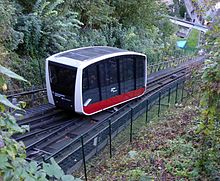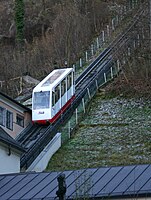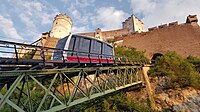Salzburg fortress railway
The Salzburg Fortress Railway is a funicular in the city of Salzburg . The cable car up to the fortress mountain there is the oldest operating cable car of its kind in Austria . It has been operated by Salzburg AG since 2000 under the brand name FestungsBahn . Centuries older, however, from Nonnberg to the fortress is the tearing train , the oldest material ropeway in the world still in operation today.
history
The fortress, which was built in 1070, was used as a barracks after being abandoned as a defense structure. Increasingly, this sight was also visited by more and more tourists. In 1890 - albeit a long way from the fortress - the Mönchsberg elevator was the first ascent aid to be built in a steel structure that was attached to the outside of the rock and no longer exists today as a purely vertical elevator.
In April 1892, construction work began on the funicular as a water ballast railway to the Hohensalzburg Fortress , which at that time was used as a barracks. In July of that year it was officially opened by the operating company Salzburger Eisenbahn- und Tramwaygesellschaft (SETG). Because of its drive, it quickly got the nickname "Tröpferlbahn". The line was equipped with three rails, with the middle rail being used alternately by both cars (each for 26 passengers). Racks based on the Riggenbach system , which were used for braking, ran between the rails . A turnout with 4 rails was built in halfway. The water was taken from the Stitsarm tunnel of the Alm canal system , the valley station was built above the water tunnel . The Almpassage has made the water tunnel in the mountain visible for several years.
From May 1, 1893, the fortress railway was connected directly to Salzburg Central Station for several years by the Salzburg tram , which at the time was still operated as a horse-drawn tram .
The railroad struggled to survive the economic crisis of the 1920s and the two world wars. After the SETG was liquidated in 1948, the Salzburg municipal transport company was responsible for the route, which in turn was absorbed by the Salzburg municipal utilities in 1950 .
Because of its dependence on water, the train had to take a break in winter. Therefore it was considered to convert the train to electric drive. On October 18, 1959, the "Tröpferlbahn" ran for the last time. The old water-powered railway and the route were demolished and a new track system with two new cars was installed. On April 16, 1960, the new electrically powered train was put into operation.
Between 1974 and 1976, the valley and mountain stations were rebuilt and adapted to the changed needs. In 1991 the cars and the drive had reached the end of their economic useful life and also had to be replaced. On April 11, 1992, the re-modernized funicular to the Hohensalzburg Fortress started operating. Car 2, in light green of the SLB from the 1970s, went to the Railway Museum in Vienna and stands there next to a Gaisbergbahn vehicle .
Since April 15, 2011, the railway has been running again with new wagons, the ones that were excavated and discarded on March 1st were sent to the vocational school for cable car technology in Hallein for training cable cars. A water spray central vacuum cleaner system with 60 m NiRo pipe was installed to clean the stone floors, and water is sprayed onto the suction nozzles.
Despite all the renovations, a riveted steel truss bridge from 1892 still supports the track on the route. Halfway along the "Abt'schen Ausweiche" is the Mönchsberg stop, which is now only used in special cases .
| 1st generation | 2nd generation | 3rd generation | 4th generation | ||
|---|---|---|---|---|---|
| Operating time A) B) | from | July 30, 1892 | April 16, 1960 | April 11, 1992 | April 15, 2011 |
| to | October 18, 1959 | November 11, 1991 | January 9, 2011 | constantly | |
| innovation | New building | Track, drive, car | Car ( 1 Paris Lodron , 2 Wolf Dietrich ), drive | Car ( 01 , 02 ) (panorama window, no valley-side driver's cab), electrical engineering (WLAN signal transmission) | |
| drive | Ballast water | Electric motor on rope deflection | detto | frequency-controlled three-phase motor | |
| Drive power | kW | - | 80 | 225 | |
| Car capacity | Pers. | 26th | 36 | 48 (3 + 2 levels) | 55 (54 + 1 car attendant, mountain side) on 3 + 1 levels |
| speed | m / s | 1 | 2.4 | 4th | 5 (maximum 5.5) |
| Gauge | mm | 1000 | 1040 | 1040 | 1040 |
| Inclined length | m | 192 | 192 | 198.5 | |
| Height difference | m | 102 | |||
| Greatest slope | % | ? | 62 | ||
| Rope diameter | mm | 33 (32-35) | 25th | ? | |
| Travel time | s | approx. 195 (calculated) | 80 | 58 | 48 (54) (without stopping halfway) |
| Transport capacity | Pers./h | 1600 | 1850 | ||
On February 21, 2011, a worker was killed at the valley station during the renovation work. A heavy component had slipped down the railway line and hit him.
Technical specifications
route
- Length: 198.5 m
- Difference in altitude: 96.6 m
- greatest gradient: 60%
- Track width: 1040 mm
- Rope diameter: 25 mm
- System: 1-lane with turnout ( Abt turnout )
drive
- automatic platform screen doors in the mountain and valley stations
- Three-phase drive 400 V
- Drive power: 225 kW
- Standard travel speed: 4 m / s
- Max. Driving speed: 5.5 m / s
- Shortest travel time: 47.4 sec.
- hydraulic released spring-loaded brake brakes (rail clamp brake)
dare
- Capacity: 55 people
- Capacity: 1880 people per hour and direction
- Length: 9.3 m
- Width: 1.9 m
- Payload: 4125 kg
- Year of construction: 2011
Location
The valley station of the fortress railway is in the left old town in the Festungsgasse. Here was the home of Joseph Haydn's brother Michael , which was also the birthplace of the Salzburg composer and pianist Joseph Woelfl (1773–1812).
The mountain station offers direct access to the Hohensalzburg Fortress.
Web links
Individual evidence
- ↑ http://www.dokumentationszentrum-eisenbahnforschung.org/festungsbahnsalzburg.htm
- ↑ Festungsbahn celebrates its 125th birthday orf.at, August 1, 2017, accessed August 1, 2017.
- ↑ Stiftsarmsystem - Denkmal unter der Erde almkanal.at, accessed July 1, 2017.
- ^ Salzburger FestungsBahn reopened April 15, 2011, accessed August 1, 2017.
- ^ Salzburger Festungsbahn with cleaning system from Stangl stanglreinigung.at, January 17, 2012, accessed August 1, 2017.
- ^ Gunter Mackinger, Franz Straka: SLB generation change at the fortress railway narrowspur-europa.at, "The narrow track", March 2011, accessed August 1, 2017.
- Jump up steeply to Austria's largest castle - the Salzburg Fortress Railway documentation center-eisenbahnforschung.org, Documentation Center for European Railway Research (DEFF), January 10, 2011, accessed August 1, 2017.
- ↑ Festungsbahn celebrates its 125th birthday orf.at, August 1, 2017, accessed August 1, 2017.
- ↑ 1943 salzburg.com, SalzburgWiki, accessed August 2, 2017.
- ^ Salzburg AG / Festungsbahn. Telephone call August 2, 2017.
- ^ Salzburger Nachrichten, February 21, 2011.
- ^ Festungsbahn salzburg.com, SalzburgWiki> Festungsbahn, May 7, 2017, accessed August 1, 2017.










